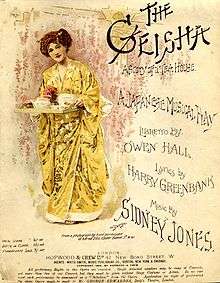Daly's Theatre
Coordinates: 51°30′40″N 0°7′46″W / 51.51111°N 0.12944°W

Daly's Theatre was a theatre in the City of Westminster. It was located at 2 Cranbourn Street, just off Leicester Square. It opened on 27 June 1893, and was demolished in 1937.
Early years
The theatre was originally built for American producer Augustin Daly by the English theatre manager George Edwardes. The architect was Spencer Chadwick, who was assisted by C. J. Phipps. The theatre was one of the first in London to be built using the cantilever system, and the Italian Renaissance and neo-classical facade was more elaborate than that of most London theatres. Likewise, the entrance hall and foyer were elaborately executed and decorated. The Victorian style to minimize colouring and design in the auditorium was abandoned, and instead bold designs and colours were used. It had a seating capacity of over 1,200 in three tiers.[1]
The theatre opened with The Taming of the Shrew, with Daly's star from his American company, Ada Rehan, playing Katharina. This was followed by Sheridan Knowles's The Hunchback, with Violet Vanbrugh, and in 1894 by Twelfth Night and As You Like It and the younger Dumas's La Dame aux camélias, with Eleonora Duse.
The Edwardes years

In 1894, Edwardes took over management of the theatre himself. He hired Sidney Jones as the resident composer and music director, and the theatre became well known for a string of highly successful Edwardian musical comedy productions composed mostly by Jones, many with additional songs by Lionel Monckton.
The shows represented a step forward in the evolution of musical theatre. They had coherent plots and music specifically composed for the plot of each piece. After the first few of these pieces, they became more like what musical comedy was to become at maturity than their Gaiety Theatre siblings, the more revue-like "Girl" musicals. The early Daly's Theatre shows, mostly with books by critic-turned-playwright Owen Hall and lyrics by Harry Greenbank and the prolific Adrian Ross, included the breakout hit, A Gaiety Girl (1894), An Artist's Model (1895), and the three most successful musical comedies of the era: The Geisha (1896), A Greek Slave (1898) and San Toy (1899). The shows starred actors such as leading lady Marie Tempest, dancer-soubrette Letty Lind, leading men C. Hayden Coffin and Scott Russell, and comics Huntley Wright and Rutland Barrington.
These were followed by A Country Girl (1902) and The Cingalee (1904), with books by James T. Tanner. Edwardes was clever at gauging the changing tastes of his audiences. For a time, he successfully presented English adaptations of continental European operettas, like The Little Michus (1905), The Merveilleuses (1906), the highly successful The Merry Widow (1907), The Dollar Princess (1909), The Count of Luxembourg (1911), Gipsy Love (1912) and Betty (1915). In this series, Percy Greenbank replaced his brother Harry, who had died at the age of 33, songwriter Paul Rubens joined the team, and new actors joined or replaced the older ones, including leading men Bertram Wallis, Courtice Pounds and Robert Evett, and leading ladies Gertie Millar, Lily Elsie, Gabrielle Ray, Isabel Jay, Louie Pounds and Evie Greene.
After Edwardes
Edwardes died in 1915, leaving his estate in considerable debt. The theatre continued to be managed by Robert Evett as part of Edwardes's estate. Evett directed and produced The Happy Day (1916) and the smash hit, The Maid of the Mountains (1917), both starring José Collins. The show ran for a record-breaking three years and saved the Edwardes estate. This was followed by A Southern Maid (1917; revived 1920) and Our Peg (later adapted into Our Nell). Evett also directed revivals of The Dollar Princess.
Later, other managements took over the theatre. In 1927, Noël Coward's famous flop Sirocco played at Daly's. After this failure, Daly's returned to musical comedies but found little further success. That's a Pretty Thing played in 1933, Charley's Aunt was revived in 1934, and Young England was transferred there in 1935. The theatre eventually closed in 1937 after the last performance of The First Legion and was sold to Warner Brothers who demolished the theatre and built a large theatre and cinema called the Warner Theatre designed by Thomas Somerford and E. A. Stone with a marble facade sculpted by Bainbridge Copnall, featuring a large relief panel in two corners depicting the spirits of sight and sound.[2] This building was demolished, but the marble frontage was retained, and the site was redeveloped as the Warner Village cinema complex. It changed hands again, and is now the Vue West End.[2]
Notes
- ↑ Daily Graphic, 28 June 1893, reprinted in Mander & Mitchenson's Lost Theatres of London.
- 1 2 "Vue West End". cinematreasures.org. Cinema Treasures. Retrieved 11 February 2014.
References
- Lamb, Andrew. "Daly's and its Continental Composers" in The Gaiety Annual (2003) pp. 19–24
- Daily Graphic, 28 June 1893, reprinted in Mander & Mitchenson's Lost Theatres of London.
External links
- Photos and information about the theatre
- Descriptions of the theatre building with photos and several original programmes.
- Daly's Theatre programmes (text) (in the Theatre Collection of the University of Kent)
- Drawings of the theatre
